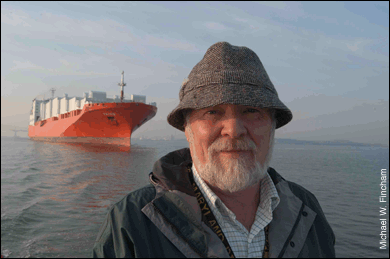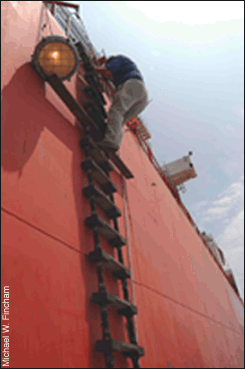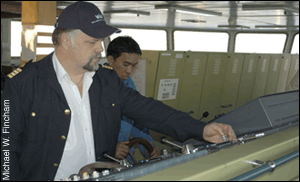Photograph: Home from another long night's journey, this time on the 870-foot Taiko, pilot Dave Van Metre has guided thousands of ships up the Bay. Photograph by Michael W. Fincham.
Contents
Bringing Big Ships
to Baltimore

Story and photos by Michael W. Fincham
Dave Van Metre spends his layover day reading and napping. He's reading John Grisham's The Last Juror because he loves a thriller. He's taking naps because he was up late the night before leading a ship down from Baltimore to the mouth of the Chesapeake Bay. And in the night to come he'll be working all the way through to dawn, guiding a Norwegian ship on a night passage back up the Bay to Baltimore. Once he gets his call, he won't have time for another nap or another thriller.
Van Metre is a reader and, as it turns out, an occasional story teller. As a Maryland Bay pilot, however, he doesn't have a lot of hair-raising stories to pass on. Those who do are apparently not the ones you want on the bridge of a tanker carrying millions of gallons of oil, enough to pollute the entire Chesapeake. Like most pilots, Van Metre is cautious, risk averse by nature and trained to avoid collisions or groundings or weather traps by thinking ahead, way ahead. He spends his work days and nights trying to steer clear of trouble.
After 40 years on the job, Dave Van Metre is now a gray beard among the pilot corps. Behind the beard are a broad face, thinning hair, and a pervasive calmness that works well on the bridges of foreign ships. From all those years on all those ships, he has some tales to share, most of them short stories, not novels. But he will have one thriller to tell before his long passage is done.
When Dave Van Metre brings big ships up the Bay to Baltimore, he is running the longest single-pilot passage in America.
Maryland Bay pilots climb aboard nearly every large, non-military ship bound into or out of Maryland waters. Standing in wheelhouses among mostly foreign crews, they guide deep-draft ships through a long, shallow estuary. Their skills are similar to a ship captain's: piloting, navigating and shiphandling for vessels of any size. But they bring to the boat something the incoming captains don't have: detailed local knowledge of all the Chesapeake Bay's trenches, shoals and dredged-out channels.
There is a mystique to their profession. Here's Mark Twain writing about his years as a river pilot: "I loved the profession far better than any I have followed since, and I took a measureless pride in it. The reason is plain: a pilot, in those days, was the only unfettered and entirely independent human being that lived in the earth." Pilots in these days may be more fettered than Twain was, but it's clear they see their job as one of the pinnacles of the maritime professions — right up there with ship's captain, but without the four-month rotations at sea. These are sailors home from the sea nearly every other night.
The mystique is part history, part mystery. Pilots have been around since Biblical times and they have worked the Chesapeake Bay since Colonial times. In 1852 three dozen freelance pilots met in a hotel in Baltimore and set up the Association of Maryland Pilots, the first state-chartered pilots organization in the country. For a century and a half, the Association has recruited and trained the state's pilots, passing down a culture of competence and an impressive record of safety. The Coast Guard lists only two loss-of-life collisions involving Maryland pilots since 1947. They are a first line of defense against ecological disasters like the Exxon Valdez oil spill in Alaska's Prince William Sound. When they bring big ships up the Bay to Baltimore, they are running the longest single-pilot passage in America.
How a pilot does his job, however, remains a mystery to most boaters on the Bay. Those of us who go oystering or crabbing or fishing or sailing seldom see a pilot. We may see a giant ship jutting up against the horizon and perhaps catch a glimpse of a solitary silhouette high up on the bridge wing, holding binoculars. How does he (or she) get a ship that big to Baltimore — without crashing into something or running aground somewhere like so many of us do?
Dave Van Metre gets his call to go to work at 20:30. A ship steaming south towards the mouth of the Chesapeake Bay has radioed in. The call went first to a watch tower on the beach side of Cape Henry,Virginia, where observers track incoming and outgoing ships. The tower radioed the Maryland Pilot Station, a red-bricked, waterside structure along Lynnhaven Inlet where pilots like Van Metre can rest between assignments in bedrooms, a lounge or a well-stocked kitchen. A dispatcher then rings Van Metre's room, jolting him out of his last nap. He shuffles down the dark corridor to a communal bathroom. An hour later he is riding in a fast launch boat, bouncing across dark, choppy water.Ten miles out is his next job: A Norwegian cargo ship, towering in the darkness, waiting for a pilot.
Riding in the launch next to Van Metre, I ask him if he ever gets nervous about climbing a Jacob's ladder. A pilot usually boards a vessel at sea by stepping off the deck of the pilot launch, grabbing hold of a rope ladder dangling down the side of the ship, then clambering up its wooden treads. "I'm always wary," he says. "I always take my time." Ships are larger now than when he started, and Jacob's ladders are longer, but he's clearly not nervous. His companion might be.
I focus on the advice one of the launch operators gave me. When a swell is running, especially out of the southwest, the launch will rise and fall along the side of the ship. The first trick is stepping onto the ladder at the top of the swell. Step off too early and the launch keeps rising, squashing you against the side of the ship. Step off too late — when the launch is falling away — and it may still lift up on the next swell and mash you.
Another trick is holding on. Always keep one hand gripping a rope and one foot standing on a tread. Never let go until the other hand has a new grip, never step up until the other foot has a new tread.
I try to forget the story that came with the advice. A pilot was in the middle of reaching for the ladder, when the launch suddenly sank away before he had a strong grip. He fell, landing on his back on the rails of the boat. He survived.Others have not.
Through the windows of the launch we see two triangles of lights, low on the horizon, barely moving against the dark sky. One is our target, the
As the launch closes in, the Taiko takes shadowy shape, a denser blackness against the night. A sudden spotlight switches on, and we see a rust-red wall, four-stories tall, looming above us. The operator matches our speed with the ship, holds the rudder over, and keeps the launch pressed against the big hull. We seem to be motionless, a stable platform parked on the sea. Van Metre walks forward to the bow of the launch, hands his travel bag and laptop to a deckhand, then steps lightly onto the ladder and starts climbing the wall.
Sliding warily along the deck, I look down and immediately regret it. Our platform is rushing across the ocean at a good clip, much faster than anybody can swim. I hand my bag and camera to the deckhand and look up. In the Bible, Jacob saw a ladder reaching from earth to heaven with angels gliding up and down on it. The only heaven I can see is half-way up the side, a square opening with a little platform jutting out and an orange-jacketed deckhand peering down. I step off, repeating my little mantra: Reach, grip, step, let go. Reach, grip, step, let go. I don't look down until the deckhand hauls me onto the platform.









![[Maryland Sea Grant]](/images/uploads/siteimages/CQ/MD-Logo.png)